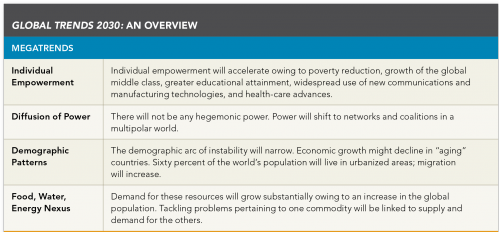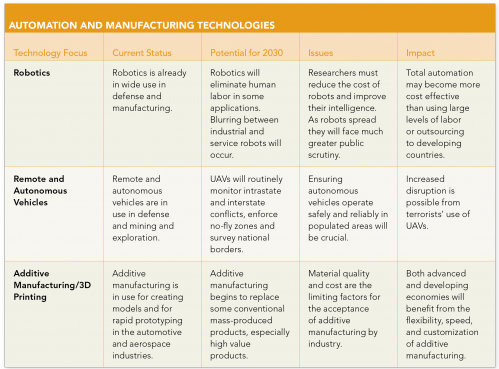A few weeks back, on one of my many flights, I had an opportunity to read Global Trends 2030: Alternative Worlds, a publication of the National Intelligence Council (NIC).1
I found Global Trends 2030 to be sometimes a disturbing but always a fascinating read.2 I would highly recommend reading this publication, not because it makes specific predictions about the future (no one can do that) but because it does an excellent job of outlining the range of potential drivers and resulting outcomes that we, as a truly global society, will need to deal with in the future. For an alternative view of what the world of 2030 might look like, another worthwhile publication is Strategic Global Outlook: 2030, Ed. by Alexander A. Dynkin.3
Global Trends 2030 is broken into three main sections: (1) Megatrends, (2) Game-Changers and (3) Potential Worlds. The last section covers scenarios resulting from the first two. I am going to concentrate my review here on the Megatrends section.
Under Megatrends, the authors detail four broad themes that will influence the geopolitical landscape over the next 15-20 years (see below).

While shifting demographics (e.g., the aging of the West) and multipolar coalitions are certainly interesting, I was absolutely fascinated by the predictions around Individual Empowerment and Food, Water and Energy Nexus. I will provide some thoughts on the Individual Empowerment section below.
Individual Empowerment
Global Trends in 2030 predicts that individual empowerment will accelerate over the next 15-20 years because of the substantial reduction of poverty, the growth of the middle class, and improvements in educational opportunities and health care. Some of the drivers behind this shift are predicted to include the widespread use of new communications and manufacturing technologies. Potentially, this newfound access could enable disruptive, destructive individual"empowerment," such as bioterror weapons or cyber instruments, both of which were formerly reserved to nation states. But improved access will likely be beneficial as well. Specifically in the case of manufacturing and automation technologies, the rise of 3D printing and robotics are predicted to change work patterns in both developed and developing worlds, thus diminishing the need for outsourcing (hurting semi-skilled workers in certain markets) but also stimulating an entirely new market of micro-manufacturers throughout the world.
Additive manufacturing could lead to large numbers of micro-factories akin to preindustrial revolution craft guilds, but with modern manufacturing capabilities. Such local micro-factories could manufacture significant amounts of products, especially those for which transportation costs are traditionally high or delivery times are long, and in the process shorten and simplify supply chains.
Later on the writers add:
Additive manufacturing could also level the playing field for those countries or organizations that missed out on earlier periods - because additive manufacturing requires less industrial infrastructure than conventional manufacturing.
The implication here is that countries that didn't or couldn't invest in infrastructure-supporting land-based telephone lines, but instead jumped straight to cellular and other wireless telecommunications methods, can begin to produce and sell their own products rather than simply watching traditional manufacturing powerhouses grab all the sales.

For the potential impact of additive manufacturing technologies in the world of 2030, see pages x, 86, 91 and 93 in Global Trends 2030.
The thinking here follows the same theme as Chris Anderson does in his book "Makers: The New Industrial Revolution" (which I had separately reviewed in my blog post here from November 2012. As I wrote then, Anderson envisions a future where micro-manufacturers will fundamentally change the entire product development and manufacturing ecosystem. According to Anderson, new product manufacturing is"no longer the domain of the few, but the opportunity of the many."
Additive Manufacturing As a Societal Change Agent?
Will the continuing explosion of additive manufacturing technologies live up to the promise suggested by Global Trends 2030 and by Anderson in "Makers: The New Industrial Revolution"?
Of course continuing technological developments will be required. For example, capturing 3D content and being able to use that content as part of a modeling session is still too hard and too expensive. But the good news is that cheaper 3D data acquisition tools and devices are trending upward. It is encouraging seeing young companies like Matterport and Floored receiving funding, and it was only a matter of time before 3D data acquisition tools would show up on Kickstarter. (See Lynx, which, at the time of this writing, has nearly reached its initial modest funding goal only a few days into the campaign kickoff.)
3D reality capture is only one part of the picture - continuing workflow simplification is key. Devices that can print with better, different and cheaper materials are required. Being able to vary material properties during the build process, and in the same build volume, will likely be key. Finally, we as an industry need to invest in the future makers, engineers and scientists with a concerted and coordinated effort to promote STEM in elementary, middle and high schools. What Lego Education does is instructive, we can learn from them.
As I wrote in my blog Reality Versus Hype: Analyzing the Innovation Hype Cycle on 3D Scanning and Printing:
I do believe, however, that we are at unique place in time, a time in which technology, market acceptance and demand are converging to catalyze change in the 3D capture and 3D printing space, carrying the space down-market from current industrial use cases. In the future, design professionals, students and children will be able to easily take innovation and inspiration from the real articles and objects that surround them, mash them up, and create entirely new designs along with a new creation and innovation cycle. What is needed is a simple-to-use, integrated end-to-end solution that allows people to easily capture, interact with, modify, manipulate and reproduce real-world 3D content. I believe we are not too far away.
I still believe that.
If I look at how much progress has been made in only the last six months, the world of 2030 looks realistic indeed.
Thanks for reading.
1 Formed in 1979, the NIC"supports the Director of National Intelligence [US] in his role as head of the Intelligence Community (IC) and is the IC's center for long-term strategic analysis." It is a bridge between the policy and intelligence communities with officers from academia, the private sector, the government and everywhere in between. For more on the NIC, click here. For a direct link to a downloadable copy of Global Trends 2030, in various forms (PDF, Kindle, etc.), click here.
This report is intended to stimulate thinking about the rapid and vast geopolitical changes characterizing the world today and possible global trajectories during the next 15-20 years. As with the NIC's previous Global Trends reports, we do not seek to predict the future - which would be an impossible feat but instead provide a framework for thinking about possible futures and their implications.
2 Unless otherwise noted, my reference point for the data in this blog has been drawn directly from the report itself.
3 A publication of the Institute of World Economy and International Relations, Russian Academy of Sciences.